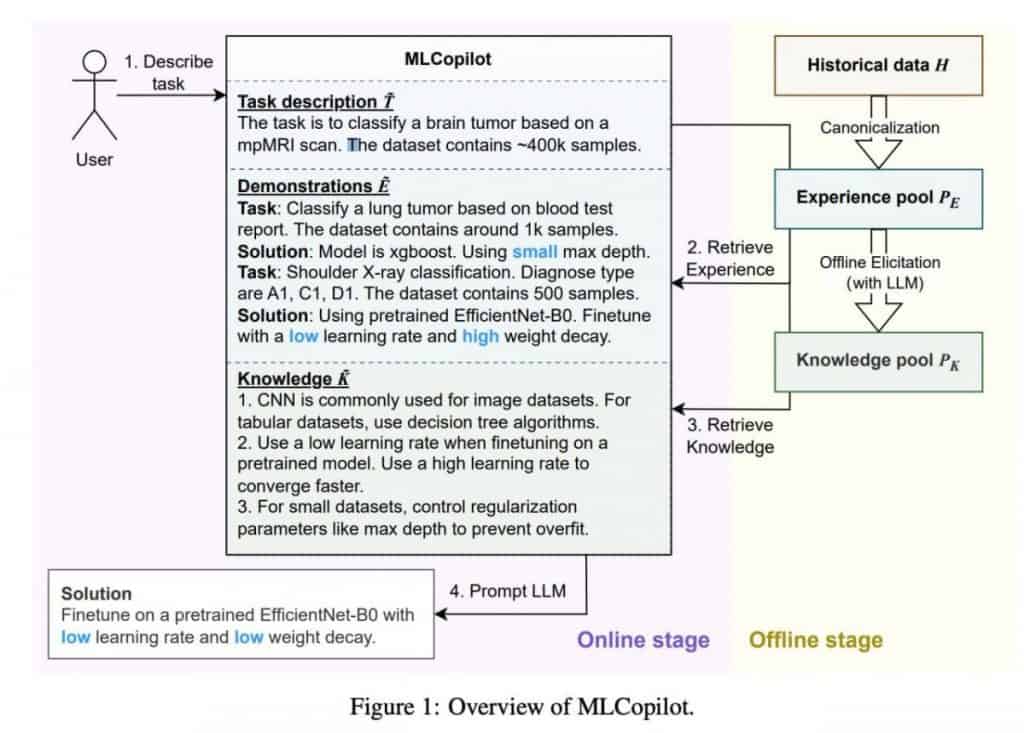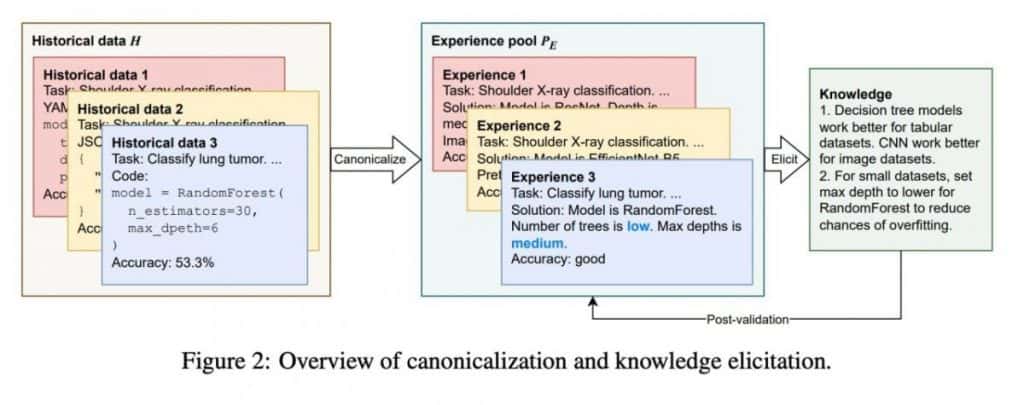MLCopilot: Leverage the Power of LLMs to Help Developers in Their ML Tasks

In Brief
MLCopilot is a new way of using machine learning models to solve challenging tasks, automating the process of selecting parameters and architectures.
It operates on two levels, offline and online, extracting knowledge from hundreds of machine learning experiments and applying a special promtp to generate a decision.
It provides tangible benefits such as speed of execution and labor cost reduction.
Machine learning models have been used to solve various tasks; however, training them has been mostly a manual process. The challenge was to select the right parameters and architectures to obtain the best results since the process requires considerable know-how and experience. With the advent of advanced technologies and large language models (LLM), such as GPT-3.5, this process can now be automated. This opens up a new way of using the power of machine learning models in solving challenging tasks: MLCopilot.

MLCopilot operates on two levels. On the offline side, entities such as the intent and model architecture are unified, with knowledge extracted from hundreds of machine learning experiments. This data forms the knowledge base on which the MLCopilot works. On the online side, the MLCopilot applies a special prompt, including relevant examples from previous experiments, to generate a decision about the best approach to solving a certain task. Such decisions have been found to be more accurate than those made by people manually selecting and applying tried-and-true algorithms.

In addition to making more accurate decisions, the MLCopilot provides tangible benefits such as speed of execution and reduction of labor costs. On the other hand, some drawbacks must be kept in mind, for instance, the need for high-accuracy data to form the knowledge base and the need to keep the model up-to-date with new experiments.
Interestingly, the estimates of experiments from history were translated into relative ones without numbers: “very low,” “low,” “medium,” “high,” and “very high.” Based on this, the model could determine what works and what does not.

Overall, MLCopilot has the potential to improve the way machine learning tasks are solved. By automatically selecting the right parameters and architecture, it allows us to leverage the power of machine learning models to save time and cost while improving accuracy. Ultimately, these benefits will benefit everyone: from individual researchers to large corporations or state organizations. This is a huge leap forward for the AI era and will surely be followed by more exciting developments.
The article ends on a frightening note for some and a motivating note for others: “We hope that the design of our method can serve as an inspiration to the wider community and contribute to the advancement of LLMs towards the goal of achieving artificial general intelligence (AGI).”
- On March 14, OpenAI announced the launch of GPT-4, an upgraded version of its artificial intelligence model GPT-3.5. It has achieved a high-grade threshold, outperforming GPT-3.5 on various study benchmarks.
Read more about AI:
Disclaimer
In line with the Trust Project guidelines, please note that the information provided on this page is not intended to be and should not be interpreted as legal, tax, investment, financial, or any other form of advice. It is important to only invest what you can afford to lose and to seek independent financial advice if you have any doubts. For further information, we suggest referring to the terms and conditions as well as the help and support pages provided by the issuer or advertiser. MetaversePost is committed to accurate, unbiased reporting, but market conditions are subject to change without notice.
About The Author
Damir is the team leader, product manager, and editor at Metaverse Post, covering topics such as AI/ML, AGI, LLMs, Metaverse, and Web3-related fields. His articles attract a massive audience of over a million users every month. He appears to be an expert with 10 years of experience in SEO and digital marketing. Damir has been mentioned in Mashable, Wired, Cointelegraph, The New Yorker, Inside.com, Entrepreneur, BeInCrypto, and other publications. He travels between the UAE, Turkey, Russia, and the CIS as a digital nomad. Damir earned a bachelor's degree in physics, which he believes has given him the critical thinking skills needed to be successful in the ever-changing landscape of the internet.
More articles

Damir is the team leader, product manager, and editor at Metaverse Post, covering topics such as AI/ML, AGI, LLMs, Metaverse, and Web3-related fields. His articles attract a massive audience of over a million users every month. He appears to be an expert with 10 years of experience in SEO and digital marketing. Damir has been mentioned in Mashable, Wired, Cointelegraph, The New Yorker, Inside.com, Entrepreneur, BeInCrypto, and other publications. He travels between the UAE, Turkey, Russia, and the CIS as a digital nomad. Damir earned a bachelor's degree in physics, which he believes has given him the critical thinking skills needed to be successful in the ever-changing landscape of the internet.


















































